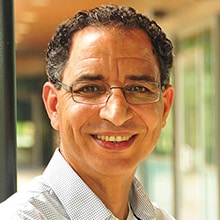Abstract
Provided here are arylpiperazine pharmacophore compositions that mitigate levodopa-induced dyskinesia and significantly improve Parkinson’s disease-like symptoms. These dopamine D3 receptor ligands have high affinity and selectivity, are orally active, and have desirable drug-like properties.
Application number
17840563
Date of Application
6/14/2022.
Inventor
Marcel Daadi
Dopamine Receptor 3 Agonist for Treating Dyskinesias – Details
Description
Parkinson’s Disease causes decreased motor control and loss of autonomous functions. The pathogenic outcome is that dopaminergic cells in the substantia nigra atrophy and eventually die, gradually decreasing dopamine release. The only pharmaceutical therapy for Parkinson’s is L-DOPA (levodopa), a metabolic precursor which is converted to dopamine by DOPA decarboxylase, temporarily increasing dopamine concentrations. Levodopa allows individuals with Parkinson’s to function normally for a period of time, with ~85% of patients receiving some clinical benefit, however, the frequency/dosage of levodopa results in inconsistent dopamine levels. Dysregulated dopamine production results in dyskinesias, which are abnormal, involuntary movements; therefore, levodopa as a treatment for Parkinson’s results in an additional disability. Currently, the only treatments for levodopa-induced dyskinesia are changing levodopa dosing/formulation, use of amantadine (an NMDA glutamate receptor antagonist), or deep brain stimulation.
Inventors at Texas Biomed have developed and evaluated a novel D3 dopamine receptor agonist compound; MC250041, with the potential to treat levodopa-induced dyskinesia. Dosing with this compound at a concentration of 10 mg/kg in dyskinetic parkinsonian marmosets reduced dyskinesias, decreased levodopa-induced hyperactivity, and enhanced sleep efficiency.
Benefits and Advantages:
- MC250041 appears to target the “right” neurologic system; dopamineregulation as compared to other available/developing drugs (e.g.,Amantadine, Safinamide, Istradefylline, mGluR antagonists, Serotoninreceptor agonists, or Vesicular monoamine transporter type 2 (VMAT2)inhibitors, which target other pathways.
- D3 dopamine receptors have a greater affinity (e.g., 420 times) fordopamine as compared to D2 receptors.
- Use of the developed MC250041 compound could result in significanteffects on neurotransmission and modulation of the dopamine function.
MARCEL DAADI, Ph.D.
Associate Professor
Dr. Daadi is an expert in regulated translational research and has developed therapeutic neural stem cell lines (NSC) for clinical use in Parkinson’s disease, stroke, and to target brain tumors in both industrial and academic settings. He discovered a novel technique of engineering these stem cell lines from pluripotent human embryonic stem cells and continues to develop this therapeutic cell line for clinical use.

‘
“Levodopa is amazing, it works like magic, but it has side effects. If we can eliminate these side effects, it could change the life of patients with Parkinson’s. We were very excited to see the robust antidyskinetic effect of our compound.”
— Dr. Marcel Daadi
INSIDE THE LAB
My research interests span both basic biology and translational research. We are pursuing reprogramming and genome-editing technologies to model neurological disorders in vitro and to understand mechanisms mediating disease development and degenerative processes following injury or disease.
Our group is currently focused on developing technologies to establish pluripotent stem cells, isolate self-renewable multipotent neural stem cells and generate specific neuronal lineages, such as dopaminergic neurons for treating Parkinson’s disease. We explore the cellular and molecular mechanisms underlying the generation and differentiation of multipotent human neural stem cells from human pluripotent stem cells.
Our lab is currently testing the safety and efficacy of therapeutic cell lines through use of relevant neurological disease animal models by applying cell delivery and multimodal molecular imaging techniques.
Texas Biomedical Research Institute pioneers and shares scientific breakthroughs that protect you, your families and our global community from the threat of infectious diseases. Texas Biomed is an independent, not-for-profit, research institute with a strong history of collaborating with global partners and contributing to the world of science and human health for more than 75 years. We are evolving into a one-of-a-kind, world-leader in the broad sciences of infectious diseases, with researchers working together in three critical areas of discovery. Our partnerships continue to expand globally to deliver new diagnostics, treatments and cures through our pre-clinical research and development programs.
Scientific Programs
- Host-Pathogen Interactions (HPI) – The HPI Program concentrates on the basic biology of infection in humans and animals and the development of disease.
- Disease Intervention & Prevention (DIP) – The DIP Program aids in the development of diagnostics, treatments and vaccines to prevent disease, reduce severity of disease and infection, if not cure infection.
- Population Health (PH) – The PH program aims to identify correlates of disease susceptibility or resistance to infectious diseases on a population level
Resource Attributes
- BSL-3 and BSL-4 facilities with laboratory capacity to perform in vitro experiments(biochemistry, cell biology, molecular genetics, and immunology) and in vivo studies(vaccine/therapeutic efficacy, pathogenesis and survival) including imaging.
- Experience with the development of nonhuman primate (baboon, macaque,marmoset) and rodent (mouse, hamster, and Guinea pig) models for evaluating diseasepathology and diagnostic, therapeutic or vaccine efficacy.
- Established standard operating procedures and protocols for biochemical,immunological and metabolism assays, deep sequencing, neutralization assays,determining bacterial and viral load among others.
- Facilities equipped with state-of-the-art equipment including Aerobiologyinstrumentation, Telemetry, Clinical Pathology Instrumentation, Flow Cytometry,Sorting, PET-CT Scan, Live-Imaging, and Single-Cell Sequencing among others.
- Active programs with NIH/DOD/BARDA/MCS, commercial and international partners.
- Studies adhering to robust quality standards to support regulatory filings with the FDAand other agencies.
For more information on Texas Biomed, visit www.txbiomed.org. To learn more about partnering with our world-class researchers to execute quality scientific studies, please contact Applied Science and Innovation at